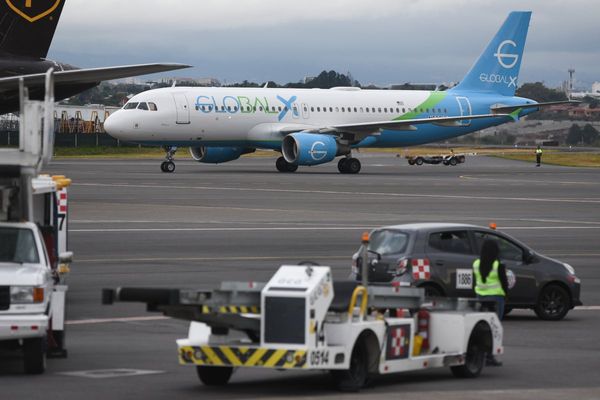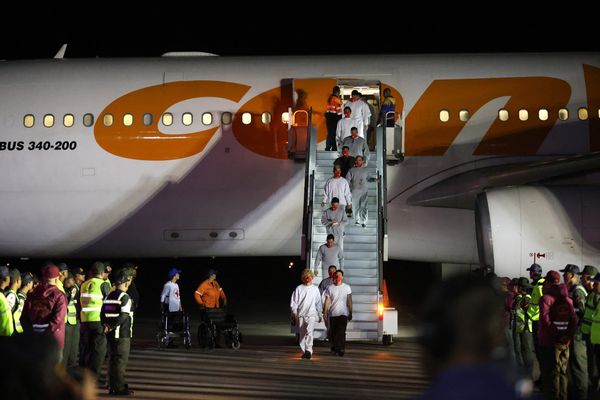
When most people think of electrification, they probably picture a battery-electric car. Think Tesla, or Rivian and the like. But what electrification really refers to is the presence of a battery in some form—that includes hybrids.
While EVs may not have taken off as quickly as automakers would have liked, they're still pushing forward with electrification as a whole. And for Toyota, that means knocking it out of the park with electrification through hybrids.
Welcome back to Critical Materials, your daily roundup for all things electric and automotive tech. Here's what's on the docket today: Toyota says half of all U.S. sales will be electrified this year, Hyundai is upping U.S. vehicle production by two-thirds in an attempt to hedge its bets against Trump's tariff threats, and Tesla is fined for the death of one of a worker. Let's jump in.
30%: Toyota Bets Big On Hybrids For 2025

Toyota, king of the multi-pathway approach to global vehicle dominance, still isn't ready to go all-in on electric. Just like Hyundai, Toyota hedges its bets—but instead of playing it safe with manufacturing location, Toyota is instead a proponent of giving powertrains an equal chance, whether that be traditional combustion, full-on electric, hybrids, or even hydrogen.
Consumers are responding to having options. And, surprisingly, they're flocking towards electrified vehicles—that is, any vehicle that uses a battery, at least in part, for its traction motor. That means PHEVs, mild hybrids, full-on battery-electric, or fuel-cell hydrogen cars. In fact, the U.S. is seeing more electrified buyers than ever, and Toyota is absolutely giddy about the success of its electrification in the States.
In 2024, Toyota's electrified portfolio accounted for up a whopping 43% of all sales in the U.S.—up from 29% in 2023. Dave Christ, Toyota North America's Group Vice President, says that the automaker is locked in to push that number to 50% this year and potentially even past that once its new battery plant starts cranking out cells.
Automotive News has the details:
While EV sales remain a challenge for Toyota dealers, gasoline-electric hybrid and plug-in hybrid sales have grown rapidly and are expected to reach a milestone, Christ said. Sales of what the automaker calls “electrified vehicles”—hybrids, plug-in hybrids, BEVs and hydrogen-fueled vehicles—accounted for 43 percent of the automaker’s U.S. sales volume in 2024, up from 29 percent a year earlier.
Christ said he expected that figure to rise above 50 percent in 2025 and that it could finish the year even higher as the automaker’s new battery plant comes online and increases availability of hybrids and plug-in hybrids.
The star of the show is Toyota's hybrid lineup. It turns out that Americans turning their nose at BEVs have still been receptive to electrification in a different way—presumably to avoid higher costs uncertainties revolving around range anxiety despite a growing EV charging network (too bad that could son fall behind).
Needless to say, this success in hybrids is one of the reasons that Toyota is less enthusiastic about any sort of mandates around EV adoption. For example, Toyota's dealers are actively lobbying against the Advanced Clean Cars II standard, a mandate that would require a 35% threshold of zero-emissions vehicles in six states (California, Massachusetts, New York, Oregon, Washington, and Vermont) across the U.S. However, Christ says that this would require "a very high level of BEV sales" to be possible, and with a rather lackluster BEV lineup at present, displaces the importance Toyota has placed around its fleet of hybrids.
Toyota's strategy, if history is any indicator, seems very likely to continue paying off. Its been amongst the leaders of the hybrid game for decades, slowly and methodically hybridizing almost everything the brand touches. The result? A striking surge in the demand of electrification as a whole while other automakers struggle to get buyers behind the wheels of BEVs.
Whether or not Toyota can ride this way up to 60% or 70% by the top of the decade remains to be seen. One thing's for sure: Toyota isn't scrambling to save face during a time when other marques are either backtracking off their EV promises or scrambling to protect their massive EV investments. Toyota is sitting pretty with its hybrid-heavy lineup and Americans are lining up to drop some serious cash on the tried-and-true brand.
60%: Hyundai Is Stepping Up Production By 66% In Try To Thwart Trump's Tariffs

While some automakers are trusting the process when it comes to the threat of tariffs on vehicles imported into the U.S. (at least publicly), Hyundai isn't taking any chances.
The Korean automaker has finally decided how it will handle the latest tariff-related saber-rattling of U.S. President Donald Trump and it may have played exactly into what the President wanted—but make no mistake, it's not because Hyundai wanted to appease Trump, but because the company may feel that it has no other choice when the alternative is facing potentially crippling levies on its imported vehicles.
The fix? Well, let's just say Hyundai has officially gone on the offense by ordering a full-out production blitz. According to a recent report from Korea Times, Hyundai is planning to up its U.S. production by a whopping 66%.
Here's the scoop from the Korea Times:
According to industry observers, Hyundai Motor Group has been preparing for such tariffs since Trump's reelection by accelerating efforts to increase its production capacity in the U.S.
The Korean automotive giant aims to boost the production capacity of its Hyundai Motor Group Metaplant America in Georgia from 300,000 to 500,000 units per year.
Additionally, it plans to leverage output from its separate Alabama and Georgia plants, currently at 356,100 units and 340,000 units per year, respectively, to elevate the group's total U.S. production capacity.
The move is designed to mitigate tariff-related costs by increasing the proportion of vehicles sold directly from U.S. plants. However, as expanding local production would lead to additional expenses, the industry is carefully deliberating specific expansion strategies.
Last year, Hyundai sold 1.7 million vehicles in the U.S. Approximately 60% of those vehicles—about 1 million—were imported from South Korea. Hyundai now plans to move that concentration closer to the 50% mark just by increasing the capacity of its new Metaplant. But it's not just stopping there.
Hyundai reportedly also plans to redirect some of the output from its plant in Montgomery, Alabama back into the U.S. The plant has an annual capacity of around 370,000 vehicles and builds the Santa Cruz, Santa Fe, Tuscon, and Genesis GV70. A small percentage of those models are then exported to Canada, Mexico, and El Salvador.
The Georgia Metaplant currently has the capacity for 300,000 units and builds the Ioniq 5 and soon-to-be Ioniq 9. The rest of its electrified lineup, however, remains vulnerable should tariffs kick in and jack up the price on other models.
It's worth also noting that Hyundai's EVs are still powered by batteries sourced from SK. Out of the Metaplant's 12 production lines, 9 are sourced from SK's local plant while the remaining are still sourced from outside of the U.S. from countries like Hungary. SK reportedly plans to expand its U.S. manufacturing capacity to support Hyundai's additional production needs.
This is a clear signal from Hyundai that it has absolutely no desire to wait around and see if it'll get slapped with additional import taxes. Instead, it's going full-tilt into bolstering its U.S. presence to avoid the need to import vehicles into the country.
Whether or not the plan will work is another story. Hyundai is certainly playing it safe by getting ahead of the storm, but it's just one of the many automakers staying on its toes amid a very unstable political climate.
90%: Feds Cite Tesla Over Worker's Death

Tesla has a lot on its plate right now. You have its falling sales, a stock roller coaster and a CEO who's also apparently a part-time politician—which might just be causing damage to the brand. Now, the U.S. Department of Labor is piling on something else with a fresh fine over safety violations that led to the electrocution death of a worker at its Austin Gigafactory last summer.
Federal regulators at the Occupational Safety and Health Administration (OSHA) have wrapped up their investigation into the death of Victor Gomez, an electrician who was killed last year while working as a contractor at the Tesla Gigafactory in Austin, Texas where it builds the Cybertruck. The investigation, according to Reuters, found Tesla to have violated workplace safety rules in connection with Gomez's death.
Reuters outlines the details:
On Wednesday, U.S. Representative Greg Casar, a Texas Democrat whose congressional district includes the Tesla plant, sent a letter to the Labor Department urging that OSHA immediately release the full results of its investigation of Gomez’s death. The letter said that a refusal to release public records on Tesla's workplace safety failures could raise questions about whether the agency is giving Musk preferential treatment.
"Americans have a right to know whether Tesla and its contractors put a man’s life at risk, and whether Tesla will follow workplace safety rules going forward," the letter read.
According to the wrongful death lawsuit filed by Gomez's family, the electrician was killed while inspecting electrical panels which should have been inactive. The lawsuit alleges negligence on Tesla's part for failing to ensure that the panels were not live.
To make matters more complicated, OSHA reportedly hasn't key details about the automaker's fine, such as what, specifically, the automaker was cited for. This has raised questions about whether or not the Department of Labor, a federal agency under the executive branch, is giving Tesla CEO Elon Musk special treatment.
This isn't the first time that Tesla was cited for workplace safety violations at Giga Texas. Last year, Tesla was fined $7,000 for two workplace violations. Workers also filed formal complaints in 2022, alleging that the automaker had failed to address workplace safety violations during the construction of the plant.
100%: Where Do We Go From Hybrids?

Hybrids seem to be polarizing. Folks either love 'em or consider them to be a stop-gap to BEVs. Then again, some even say the same about BEVs to hydrogen-powered FCEVs—but the infrastructure for BEVs makes plugging in a lot more feasible at the present time.
That being said, it seems like automakers are ready to really put their money into hybrids. General Motors, for example, confirmed last year that its plug-in hybrids were coming back to North America. And if Toyota's sales success is anything to measure, it seems like the American public has really taken to the idea of the powertrain, especially since it means no range anxiety.
And coming full circle is the new incoming fad of Extended-Range EVs (EREVs). These cars come equipped with a motor capable of recharging the car's battery—think of it less like a traction motor and more like a generator on wheels.
Where do you feel like the future of hybrids play into electrification? Are they something that will stay around for a while, or are they truly just a stop-gap to better EV technology? Let me know in the comments.







